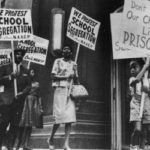When minority students decided to take their challenge of the “separate but equal” doctrine to the Supreme Court, the 1954 decision handed down by the court in Brown v. Board of Education and enforced by the executive branch, changed their lives and America forever. In this lesson plan, based on the Annenberg Classroom video “A Conversation on the Constitution: Brown v. Board of Education,” students gain insight into decision-making at the Supreme Court, learn about the people behind the case, construct a persuasive argument, and evaluate the significance of Brown v. Board of Education.
Balancing Religious Freedom and Government Interests
This lesson explores the Supreme Court case Tandon v. Newsom (2021) regarding religious liberty.Throughout the COVID-19 pandemic, the state government of California along with many of its county governments placed restrictions on gatherings of people. One of their regulations had the effect of preventing more than three households gathering together at a time for any in-home prayer and Bible studies. Plaintiffs sued the state, arguing that these restrictions violated the First Amendment since many secular businesses were allowed to have more than three households of people within it at any time, and that therefore religion was being specifically discriminated against. The Supreme Court recently released a per curiam (unsigned) decision concerning the constitutionality of these regulations.
19th Amendment: Women’s Right to Vote
In this learning module, students will trace the roots of the women’s rights movement, from early reform efforts in the 1800s to the ultimate decision to pursue voting rights. This unit explores the constitutional arguments over women’s suffrage, the historical context of the fight for suffrage over 70 years, and the tactics suffragists used to persuade state legislatures and the national government to recognize voting rights for women.
Comparing Impeachments Across History
Use this lesson alongside The Impeachment of Andrew Johnson Decision Point to introduce students to the concept of impeachment and how it has been used throughout U.S. history.
Freedom of Assembly: The Right to Protest
This lesson will focus on freedom of assembly, as found in the First Amendment. Students will consider the importance of the right to assemble and protest by analyzing cases where First Amendment rights were in question. Using the case National Socialist Party of America v. Village of Skokie, students will consider if the government is ever allowed to control the ability to express ideas in public because viewpoints are controversial, offensive, or painful. Students will use primary sources and Supreme Court cases to consider whether the courts made the correct decision in the National Socialist Party v. Skokie case. Students will be able to form an opinion on the essential question: Is the government ever justified to restrict the freedom to assemble?
U.S. Supreme Court Decisions and Justices Who Made Them
“Who cares what old people in black robes say?” As an educator you care. The challenge is how do you get your students excited about Article III of the Constitution. Constituting America has organized 90 Supreme Court cases of influential and history-changing decisions in its Constitution Archives. Need a judicial decision on what you are studying? Find it here. Need a Supreme Court ruling on a current event? Find it here. You get the picture. The material you seek is here. Your challenge, should you accept it, is make it come alive to your students.
Local Politics: The Need for Compromise
This lesson examines the process of local decision making and its need for citizen input and compromise. Students simulate a local city/county council session and advise the council on public policy. Students are asked to consider the viewpoints of different citizen groups in order to reach a compromise that will benefit the entire community. This lesson can be used with a unit on local politics and can be adapted to reflect issues of compromise in your school or community. Free registration required to access the lesson plan.
When National Security Trumps Individual Rights
On December 18, 1944, the U.S. Supreme Court handed down one of its most controversial decisions when it upheld the government’s decision to intern all persons of Japanese ancestry (both alien and nonalien) on the grounds of national security. Over two-thirds of the Japanese in America were citizens and the internment took away their constitutional rights. In this lesson, students evaluate the consequences of past events and decisions related to the Supreme Court case Korematsu v. United States (1944). They consider the challenges involved when trying to balance civil liberties and national security during threatening times and reflect on the lessons learned about civil liberties from the justices in the Korematsu case.
Actions That Changed the Law
In 1998, when Lilly Ledbetter filed her complaint of wage discrimination against the Goodyear Tire and Rubber Co. with the Equal Employment Opportunity Commission, her goal was to get equal pay for equal work because that was the law. She had no idea that her decision would eventually involve all three branches of government and result in a law with her name on it – the Lilly Ledbetter Fair Pay Act of 2009.
Teen Curfew
In this lesson, students will consider a proposed teen curfew law in a mock city council session. The class is divided into groups; one group is the city council, and the others represent the interests of groups of citizens – merchants association, county school board, etc. This exercise helps show students how citizens can be involved in policy change and decision making.
